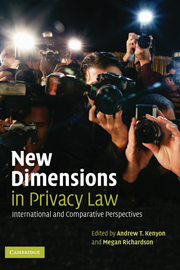Book contents
- Frontmatter
- Contents
- List of contributors
- Preface
- 1 New dimensions in privacy: Communications technologies, media practices and law
- 2 Privacy and freedom of speech
- 3 Revisiting the American action for public disclosure of private facts
- 4 The internet and private life in Europe: Risks and aspirations
- 5 APEC's privacy framework sets a new low standard for the Asia-Pacific
- 6 Copyright, privacy and digital rights management (DRM)
- 7 Why there will never be an English common law privacy tort
- 8 The ‘right’ of privacy in England and Strasbourg compared
- 9 Privacy and constitutions
- 10 Celebrity privacy and benefits of simple history
- Bibliography
- Index
- Index of laws and directives
- Index of case references
3 - Revisiting the American action for public disclosure of private facts
Published online by Cambridge University Press: 24 July 2009
- Frontmatter
- Contents
- List of contributors
- Preface
- 1 New dimensions in privacy: Communications technologies, media practices and law
- 2 Privacy and freedom of speech
- 3 Revisiting the American action for public disclosure of private facts
- 4 The internet and private life in Europe: Risks and aspirations
- 5 APEC's privacy framework sets a new low standard for the Asia-Pacific
- 6 Copyright, privacy and digital rights management (DRM)
- 7 Why there will never be an English common law privacy tort
- 8 The ‘right’ of privacy in England and Strasbourg compared
- 9 Privacy and constitutions
- 10 Celebrity privacy and benefits of simple history
- Bibliography
- Index
- Index of laws and directives
- Index of case references
Summary
The 1981 American film Absence of Malice, although lopsided against the press in its account of journalism gone bad, contains one indelible scene. In a Miami neighbourhood's early morning hours, a tense young woman sits on a front porch, waiting for the newspaper boy. Soon enough, he pedals up the street and tosses papers on all the identical yards, finally reaching hers. She anxiously pulls the paper from its plastic bag and clumsily unfolds it. The story is on page one. We don't see what it says, but we know. It reports that she, a Catholic secretary in a parochial school, had an abortion the previous year, and that on the day of the abortion, she was accompanied by a man who is suspected of killing a union leader on the same day. Her story is news; she could be the suspect's alibi. She slowly refolds the paper and forces it back in its container. She then runs in despair to all the other yards, gathering each paper: her world must not learn about the abortion. Of course, her efforts are futile.
The irony of the scene is compelling. Although American constitutional law strongly protects individuals from the state's usurpation of highly intimate decisions – relating to such things as contraception, abortion, and sexual conduct – the common law is famously tentative in shielding individuals from privacy invasions by the press, even about the same matters.
- Type
- Chapter
- Information
- New Dimensions in Privacy LawInternational and Comparative Perspectives, pp. 32 - 59Publisher: Cambridge University PressPrint publication year: 2006

